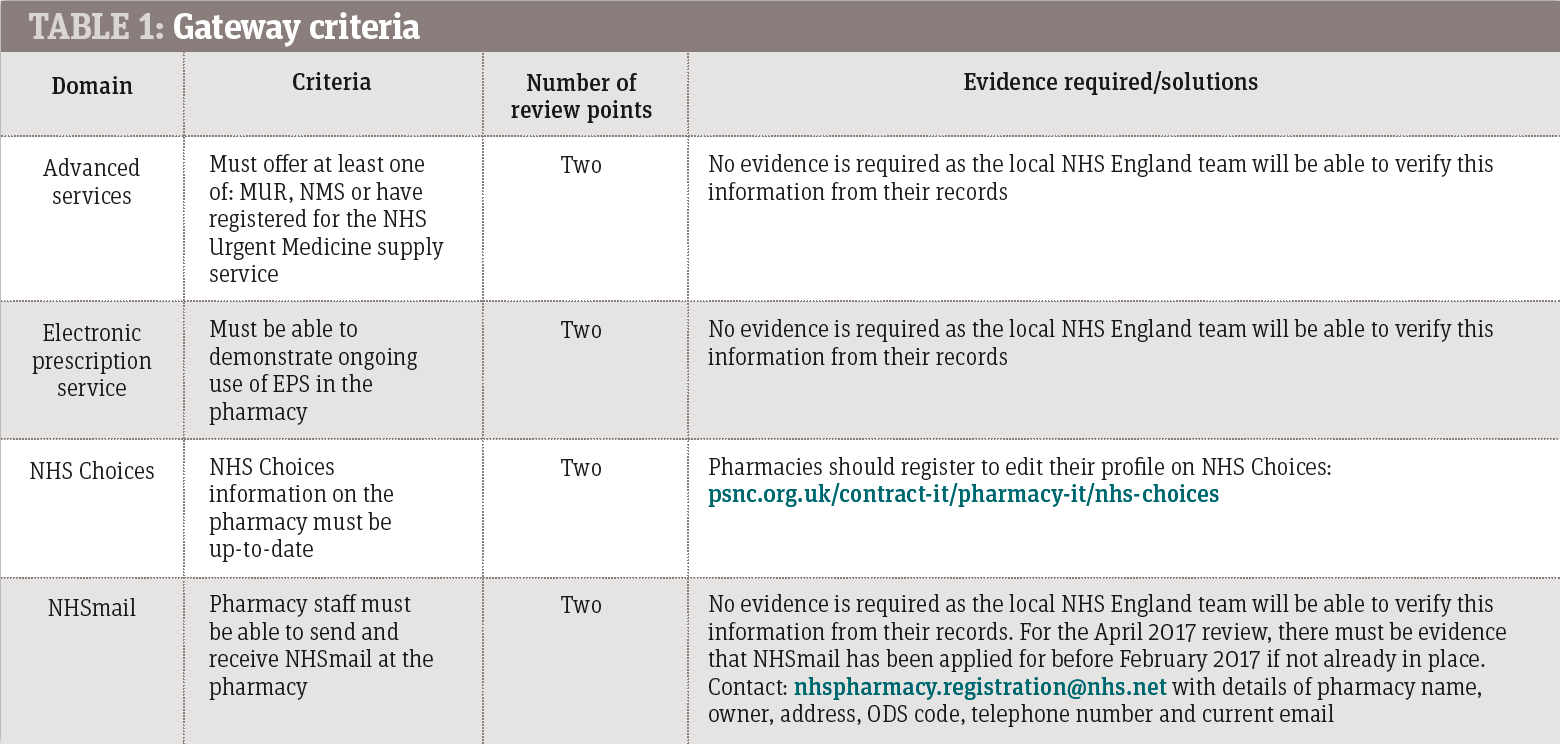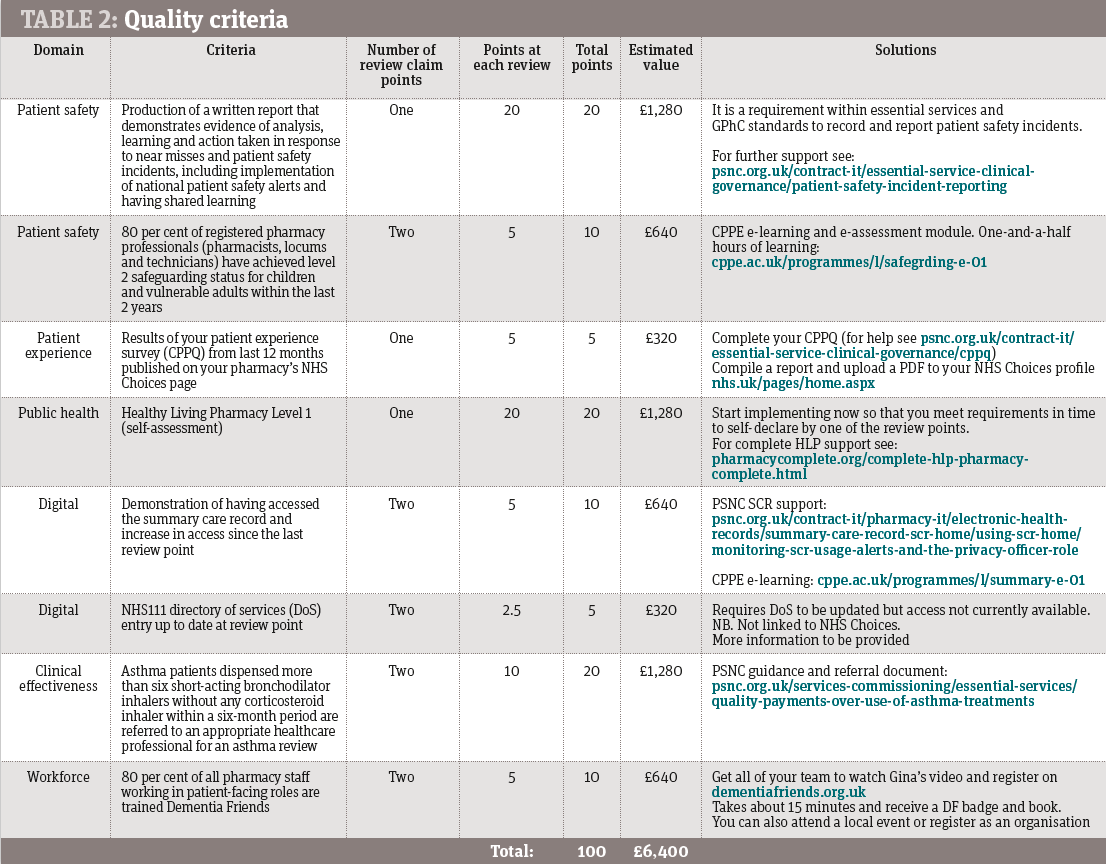Getting to grips with the Quality Payments scheme
Record learning outcomes
The landscape in which community pharmacy operates will continue to change and the sector must adapt to meet these evolving needs. Achieving the new quality payment is just the start of that process, say Mike Holden and Deborah Evans from Pharmacy Complete
AS PART OF the twoyear funding settlement for contractors in England imposed from December 2016, the Government has included a new Quality Payments (QP) scheme with four Gateway criteria (see Table 1) and eight Quality criteria (see Table 2).
The scheme, which runs from April 2017, aims to drive improved quality and value into the current contractual framework. It comes with a £75m budget €“ money taken from the reduced global sum for 2017/18.
Quality criteria have always been part of the accreditation process for the Healthy Living Pharmacy (HLP) initiative and it is good to see the two things coming together alongside a number of other important markers such as the asthma referral criteria, which may be built on as the scheme evolves to drive clinical outcomes.

Why is engagement critical?
The scheme is voluntary but contractors should aim to achieve all the criteria or they will lose a further £6,400 of funding in addition to the announced cuts. Engaging in this scheme will also actively demonstrate willingness and ability to deliver quality that may create future opportunities at local and national level. There has already been evidence of this with HLP as a marker of quality, with some local commissioners recognising the commitment that comes with the quality mark and commissioning services from these pharmacies ahead of those who have not developed their practice in the same way.
How do you qualify?
To qualify for part or all of the payment, you will have to first meet four Gateway criteria that underpin the quality and integration agenda.
You may already meet these criteria or very quickly could do so:
- You must provide at least one advanced service (MURs, NMS or be registered for the new Urgent Medicines service)
- Your NHS Choices entry must be up-to-date
- You must be able to use NHSmail
- You must utilise the electronic prescription service.
What are the Quality criteria?
The eight Quality criteria are worth a total of 100 points, with each point worth £64 (adding up to a potential £6,400 per pharmacy per year). However, the £75m budget will be shared among those who actually engage, so there may be more available for early adopters, particularly in the first year.
Some criteria are relatively easy to achieve and some will require more planning and some investment. We strongly recommend that you involve your team in developing a plan to meet the criteria, ensuring that they understand why this is necessary and what the benefits are to them and to your pharmacy. Working together as a team will help with sustained change and reduce the burden on you.
The Pharmacy Complete 'Quality Payments Quick Guide'1 illustrates some of the solutions to consider and PSNC also has a range of resources on its QP hub page to guide you through the scheme and help record evidence. Three of the criteria (worth 45 points) have one review and claim date, while the other five have two. The claim dates will be April 28 and November 24 and this will be done through the NHSBSA, either electronically or on paper. You may already meet a number of these criteria, but you must ensure that at the time of making the claim you have the evidence in place.
Assessing whether pharmacies are achieving what they say they are doing is likely to be done through the Community Pharmacy Assurance Framework (CPAF), but smart ways of monitoring will undoubtedly be employed. PSNC has agreed to licence PharmOutcomes to provide an online QP framework to support all contractors and also an asthma referral tool.
For those pharmacies that have yet to start their Healthy Living Pharmacy journey, achieving the HLP selfassessment quality criteria may have the longest lead-time €“ so we recommend you start planning now to ensure you achieve payment worth £1,280 in the 2017/18 financial year, preferably in the April claim. It is worth noting that selfdeclaration of HLP Level 1 status is valid for two years, providing the criteria continue to be met, so any required investment is actually worth £2,560.
Two criteria concern patient safety. Recording and acting on near misses and patient safety incidents is part of the essential services specification and GPhC standards, but you will be required to evidence a written report to achieve the 20 points available. Safeguarding training for registered pharmacists and technicians is worth a total of 10 points and covered by the CPPE's e-learning course that takes one-and-a-half hours.
The digital agenda is a major part of the NHS plan so it is no surprise that two criteria fall into this area. We are still uncertain how the NHS111 Directory of Services will be updated but pharmacies already have the opportunity to access the summary care record and will need to demonstrate increased usage to improve patient care and safety. Patient experience is at the core of what pharmacists do and the annual survey (CPPQ €“ part of Essential Services) is a means to learn from and improve that experience. The criteria requires the report to be uploaded onto NHS Choices.

Conclusion
This next year is going to be a very challenging period for pharmacy contractors, and despite the predicted modelling it will be difficult to fully understand the impact on their business. Minimising exposure by achieving all quality payments as early as possible will help mitigate further funding cuts and, although counter-intuitive at a time of cost-containment, investment in team development has never been more important.
REFERENCES
- Pharmacycomplete.org/qps-guide.html
